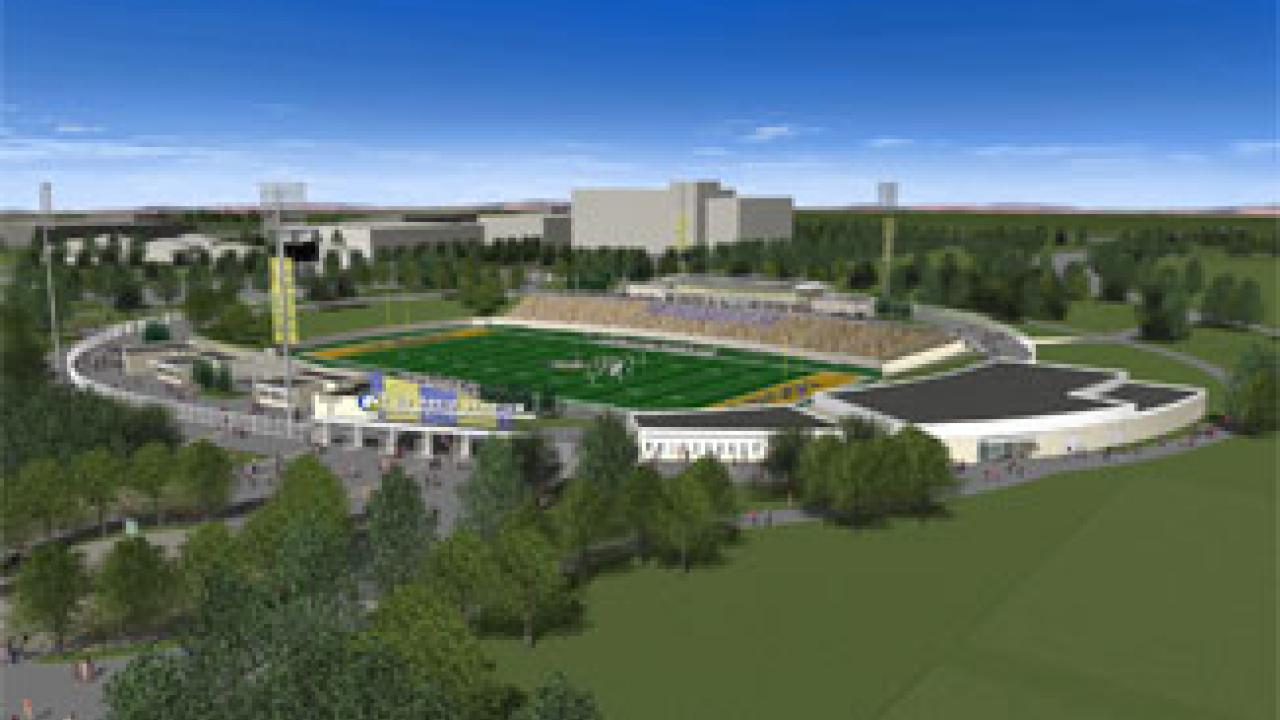The UC Regents on Jan. 20 gave a big boost to UC Davis' proposed multi-use stadium, approving both the design and external financing plan for the $29.75 million complex that is now expected to open in fall 2006.
The full Regents board vote followed an earlier Committee on Finance vote to approve the stadium's external financing plan, and an earlier vote by the regent's Committee on Grounds and Buildings to approve the design.
"We are certainly heartened and excited by the approval of the multi-use stadium by the Board of Regents," said Janet Gong, associate vice chancellor for student affairs. "Their support marks a major milestone in the campus' efforts to complete this project and we look forward to providing our students with this wonderful new venue for their use."
As planned, the stadium will include seating for as many as 15,000 spectators, but its design will be expandable to accommodate up to 30,000. It will be located on the western edge of the main campus, at the corner of Hutchison Drive and La Rue Road.
The multi-use stadium will serve as the home field for both the UC Davis football and women's lacrosse programs. It will also provide a venue for community events, such as high school athletic events, concerts and commencement ceremonies. The initial design concept calls for permanent seating for 10,000 to 15,000 spectators -- a figure that will be greatly determined during the construction bidding phase -- with basic amenities such as locker rooms, club room and an enclosed press box.
The stadium complex is one of the projects funded by the 1999 Facilities And Campus Enhancement Initiative (F.A.C.E.). Student-based fees from the F.A.C.E. Initiative account for almost two-thirds of the $29.75 million project cost, with the remaining funds comprising private donations and other revenues.
"Having a multi-use stadium on campus is exciting for our student-athletes and for intercollegiate athletics," said Greg Warzecka, director of athletics. "More importantly, it fulfills the hopes and dreams of those who proposed the F.A.C.E. Initiative and worked so hard to get it passed."
Student regent views
There were concerns expressed about the cost. Student regent Jodi Anderson pulled the item from the finance committee's consent agenda, noting that student-approved fees are covering the majority of the stadium's cost.
"I'm not taking issue with the right of students to vote" on such facilities, she said, "but I think on a systemwide basis we should monitor and understand these issues so we have a comprehensive policy to address the issue of affordability."
She noted that UC Davis' fees are higher than other UC campuses' fees. When the campus's fees are combined, however, with Davis' generally lower living expenses, the overall cost of attending UC Davis compares favorably to the other campuses.
UC Davis law student and regent-designate Adam Rosenthal joined Anderson in asking that regents devote "a significant amount" of discussion time at their March meeting to the issue of systemwide student referenda and overall affordability.
Also, Lt. Governor Cruz Bustamante questioned what he saw as "an awfully low" percentage of gift dollars supporting the stadium. "Many campuses do a much better job of raising external funds for major capital projects," he said. "It doesn't seem right to put the burden on the students."
Regent and finance committee chair Richard Blum responded that the campus "has done a very good job of raising funds on a myriad of other projects."
Fundraising under way
The Athletic Development office launched a capital campaign in July 2001 to raise the private funds needed for the stadium's initial phase. Naming opportunities are still available for numerous stadium features, including the press box, main gate and stadium box seats.
Today, the stadium fund has a little more than $3.4 million, including more than $2.5 million in gifts, pledges and accrued interest and $895,000 from a UC Davis campuswide beverage agreement with Coca-Cola.
The university signed a non-exclusive agreement last year with the Sacramento Coca-Cola Bottling Co. for the rights to sell soft drinks in campus vending machines and student housing dining areas for 10 years. In return, the campus will receive $5 million over the 10-year life of the contract, with a portion of it going to the stadium project and the balance managed by Student Affairs to help support Memorial Union services and other activities.
UC Davis has engaged the architectural firm of Ellerbe Becket to consult in the early concept designs and stadium renderings. Ellerbe Becket has served as primary and design architect for such sports facilities as Bank One Ballpark in Phoenix, Ariz., the Fleet Center in Boston, Mass., and the Walter A. Haas, Jr. Pavilion on the Berkeley campus.
The full build-out of the stadium features additional permanent seating for as many as 30,000 spectators, lighted practice fields and an enclosed club room.
Other campus projects funded by the 1999 F.A.C.E. Initiative are the Schaal Aquatics Center, which became fully operational in January 2004, and the Activities and Recreation Center (ARC), which opened in April 2004. The ARC has become a major student center on campus, currently averaging daily attendance of nearly 4,300.
Media Resources
Amy Agronis, Dateline, (530) 752-1932, abagronis@ucdavis.edu
